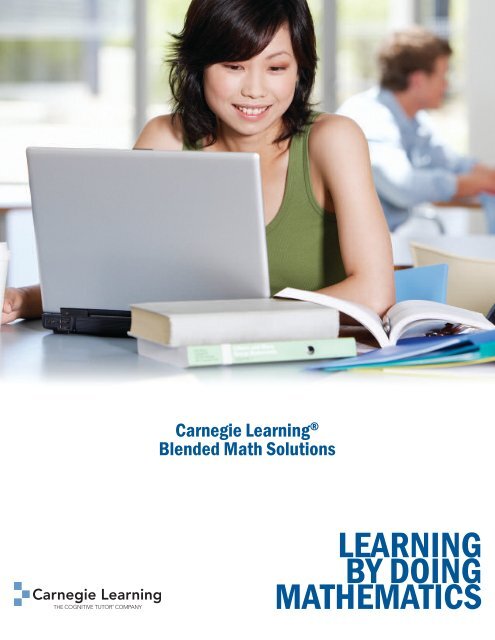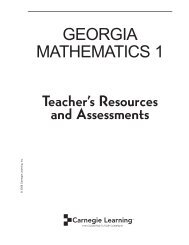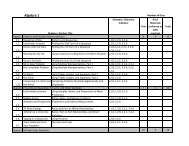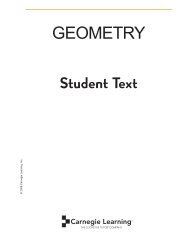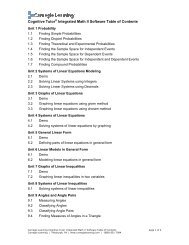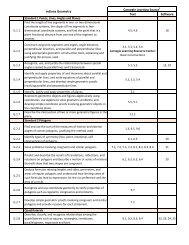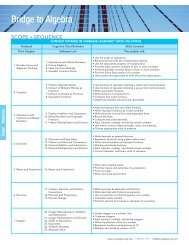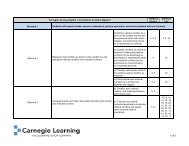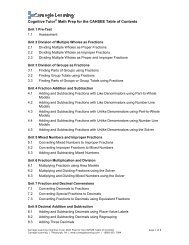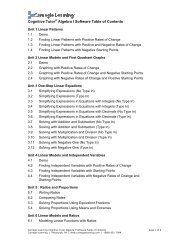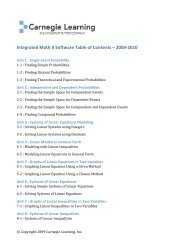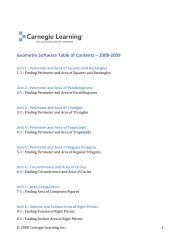LEARNING BY DOING MATHEMATICS - Carnegie Learning
LEARNING BY DOING MATHEMATICS - Carnegie Learning
LEARNING BY DOING MATHEMATICS - Carnegie Learning
Create successful ePaper yourself
Turn your PDF publications into a flip-book with our unique Google optimized e-Paper software.
<strong>Carnegie</strong> <strong>Learning</strong> ®<br />
Blended Math Solutions<br />
<strong>LEARNING</strong><br />
<strong>BY</strong> <strong>DOING</strong><br />
<strong>MATHEMATICS</strong>
The Need for 21 st Century Classrooms<br />
Today’s students have grown up in a digital world where instant messaging and listening<br />
to MP3s while doing homework is part of their studying routine. Students dislike<br />
traditional classroom instruction where lectures are the primary mode for delivering<br />
instruction. Instead, they prefer to have opportunities to work cooperatively and to learn<br />
using technology.<br />
<strong>Carnegie</strong> <strong>Learning</strong> ® Blended Math Curricula<br />
We offer a unique solution to address the needs of today’s secondary students.<br />
<strong>Carnegie</strong> <strong>Learning</strong> Blended Math Curricula provide a model for core math instruction<br />
that is comprised of <strong>Carnegie</strong> <strong>Learning</strong> ® Textbooks and Cognitive Tutor ® Software. Our<br />
standard implementation involves three days of collaborative learning in the classroom<br />
and two days learning with our technology. <strong>Carnegie</strong> <strong>Learning</strong> offers blended solutions<br />
for the following core math programs:<br />
>> Algebra readiness (titled Bridge to Algebra)<br />
>> Algebra I<br />
>> Geometry<br />
>> Algebra II<br />
>> Integrated Mathematics I–III<br />
Our unique approach for blending collaborative classroom instruction with<br />
adaptive learning technology has been proven effective. The U.S.<br />
Department of E ducation recognizes <strong>Carnegie</strong> <strong>Learning</strong> Algebra I as one<br />
of the only math curricula that is scientifically proven to have significant,<br />
positive effects on student learning. In fact, research has shown that<br />
students using the blended <strong>Carnegie</strong> <strong>Learning</strong> ® Algebra I curriculum:<br />
>> Demonstrate 85% better performance on assessments of complex<br />
mathematical problem solving and thinking<br />
>> Achieve 15-25% better scores on the SAT and Iowa Algebra Aptitude Test<br />
The standard<br />
implementation for<br />
all <strong>Carnegie</strong><br />
<strong>Learning</strong> blended<br />
curricula is three days<br />
in the classroom using<br />
the textbooks and two<br />
days using the Cognitive<br />
Tutor ® software.<br />
>> Have a 70% greater likelihood of completing subsequent Geometry and<br />
Algebra II courses<br />
>> Perform 30% better on questions in the TIMSS assessment<br />
In 28 years of teaching, I would have to<br />
say that I’ve seen more students be<br />
successful, I’ve seen more students know<br />
mathematics than I ever have before.<br />
And I think it wouldn’t be possible<br />
without the integrated curriculum and<br />
without the materials provided by both<br />
the state and <strong>Carnegie</strong> <strong>Learning</strong> that we<br />
are using.<br />
Mark Argo<br />
Math Teacher<br />
Morgan County High School
Applied Research Model<br />
& Evidence of Effectiveness<br />
<strong>Carnegie</strong> <strong>Learning</strong> is the leader in using<br />
cognitive science to develop a researchbased<br />
model for how students learn.<br />
This model is the foundation for<br />
developing our adaptive technologies in<br />
the Cognitive Tutor software. In fact, we<br />
are the only publisher that has a<br />
continuous improvement model for<br />
enhancing our instructional software.<br />
Annually, we’ve collected over 42<br />
million observations of students’<br />
studying (that’s approximately one<br />
action for each student every seven<br />
seconds). We use the data to enhance<br />
our materials to provide the best fit for<br />
how students learn.<br />
In numerous studies, <strong>Carnegie</strong> <strong>Learning</strong><br />
solutions consistently have shown a<br />
significant effect on student learning<br />
outcomes resulting in improved<br />
academic achievement in mathematics.<br />
Please visit our research section of our<br />
website at www.carnegielearning.com<br />
to view or download the results.<br />
Key Textbook Benefits:<br />
>> Students like working cooperatively and become active participants in math class.<br />
>> Students better relate to math when solving real-world problems.<br />
>> Students make connections and understand key math concepts when they encounter<br />
multiple representations.<br />
>> Teachers are better supported with materials and tips for facilitating a collaborative learning<br />
environment.<br />
>> Consumable model allows for new textbooks annually – with meaningful updates made<br />
each year.<br />
Key Software Benefits:<br />
>> Students must show mastery of each discrete skill required to solve math problems prior to<br />
progressing through the software.<br />
>> Delivers a mastery learning model within rich, rewarding problem solving contexts.<br />
>> Uses true artificial intelligence to monitor student interactions and assesses skills to<br />
individualize instruction.<br />
>> Offers continuous, formative assessment throughout curriculum. Also includes summative<br />
assessments.<br />
>> Review Mode offers students the option to review and practice skills prior to exams.<br />
>> Students can view their progress via the Skillometer which motivates them to do their best<br />
work and master skills.<br />
>> Teachers can review student performance data.<br />
>> Teachers can modify assessments.<br />
Key Professional Development Benefits:<br />
>> Develop effective strategies for implementation of curricula.<br />
>> Discuss student-centered classroom strategies.<br />
>> Develop effective scaffolding and extension questioning strategies.<br />
>> Integrate technology effectively into the instructional process to enhance understanding.<br />
>> Improve teacher capacity including both content and pedagogical knowledge.
STUDENT<br />
TEXTBOOK SET<br />
Each student receives a textbook set<br />
that contains the following three books.<br />
Student Text<br />
The Student Text is a consumable<br />
textbook designed for students to take<br />
notes and work problems directly in<br />
each lesson. Each lesson contains<br />
objectives, key terms, and problems that<br />
help the students to discover and<br />
master mathematical concepts.<br />
Student Assignments<br />
The Student Assignments book contains<br />
one assignment per lesson and skills<br />
practice activities. It is designed to move<br />
with the student from classroom to<br />
home to lab time so that students can<br />
repeatedly practice the skills taught<br />
in the lesson.<br />
Homework Helper<br />
The Homework Helper book is designed<br />
to help parents and care givers be more<br />
informed about the concepts being<br />
covered in the student’s math course.<br />
Students are encouraged to keep the<br />
Homework Helper at home. It contains<br />
one activity per lesson including<br />
examples of the skills taught in the<br />
lesson and several practice problems.<br />
Answers to the practice problems are<br />
provided in the back of the Homework<br />
Helper book.<br />
What Makes <strong>Carnegie</strong> <strong>Learning</strong> Student Texts Engaging<br />
<strong>Learning</strong> By Doing ® Principals<br />
<strong>Carnegie</strong> <strong>Learning</strong> believes that students develop math<br />
understanding and skills by taking an active role and<br />
responsibility for their own learning. With <strong>Carnegie</strong> <strong>Learning</strong><br />
textbooks students become engaged in solving contextual<br />
math problems that strengthen their conceptual<br />
understanding of math topics. Rather than encouraging<br />
students to memorize procedures, we provide them<br />
opportunities to think and work together in small groups.<br />
Mathematical Discourse<br />
Throughout the student text icons prompt different forms of<br />
student communication. These icons may instruct students to<br />
work independently, work with groups, or share ideas with the<br />
class. Encouraging mathematical discourse provides<br />
opportunities for students to explain their thoughts and<br />
processes for solving math problems.<br />
Real-World Context<br />
Students work with their peers to solve real-world problem<br />
situations like using percents for leaving a tip in a restaurant<br />
or using a graph of an equation to determine the number of<br />
days it will take to build miles of highway. They become more<br />
engaged in learning mathematics when they see how it plays<br />
a significant role in everyday life.<br />
Think for<br />
Yourself<br />
Work With<br />
a Group<br />
Share With<br />
the Class
TEACHER<br />
TEXTBOOK SET<br />
Each teacher receives a textbook set that<br />
contains the following books.<br />
Teacher’s Implementation Guide<br />
The Teacher’s Implementation Guide<br />
contains a lesson map for each student<br />
text lesson. The lesson map includes<br />
each lesson’s objectives, key terms,<br />
NCTM standards, essential questions,<br />
warm up questions, open-ended<br />
questions, and closing activities. An<br />
image of each student text page,<br />
including answers, is provided in the<br />
Teacher’s Implementation Guide.<br />
Teacher’s Resources and<br />
Assessments<br />
The Teacher’s Resources and<br />
Assessments book contains five tests per<br />
chapter of the student text. The tests are<br />
a Pre-test, a Post-test, a Mid-Chapter<br />
Test, an End-of-Chapter test, and a<br />
Standardized Test Practice.<br />
The Teacher’s Resources and<br />
Assessments book contains the<br />
assessments with answers in place and<br />
also includes answers in both the<br />
student assignments and student skills<br />
practice pages.<br />
What Makes <strong>Carnegie</strong> <strong>Learning</strong> Teacher Materials Valuable<br />
Student-Centered Classroom<br />
In a student-centered classroom, the teacher facilitates<br />
learning and coaches students to master math concepts and<br />
procedures. Little time is spent on delivering lectures. Instead,<br />
teachers lead students in completing task-based lessons and<br />
fostering discourse where students share solutions to problems<br />
and explain their mathematical reasoning.<br />
Lesson Map<br />
The teacher support materials help teachers guide instruction.<br />
The lesson map provides recommendations like how and when<br />
to group students for problem investigations, offers guiding<br />
questions to assess student understanding, and provides notes<br />
and tips regarding common student misconceptions and<br />
errors. It also provides suggestions for closing lessons,<br />
assigning follow-up activities, delivering assessments, and<br />
space to record teacher reflections.<br />
Task-Based Lessons<br />
The lessons and activities are carefully designed to help<br />
teachers engage students in learning mathematics. The<br />
task-based lessons are organized by problem scenarios<br />
and investigations. For example, a problem scenario about<br />
tipping in a restaurant may be designed to help students<br />
use percents. The activities may require students to convert<br />
between fractions, decimals, and percents and consider<br />
mathematical relationships. The real-world math tasks<br />
motivate students to learn and help them to consider how<br />
mathematics is a part of their daily lives.
COGNITIVE TUTOR ®<br />
SOFTWARE FEATURES<br />
Based on over 20 years of research into how students think and learn, the Cognitive Tutor ® Software was developed around an artificial intelligence<br />
model that identifies weaknesses in each individual student’s mastery of mathematical concepts. It then customizes prompts to focus on areas where<br />
the student is struggling, and sends the student to new problems that address those specific concepts.<br />
Innovative Research-Based Pedagogy<br />
>> Engages students directly in problem solving.<br />
>> Uses concrete, real-world scenarios.<br />
>> Prompts a student to think abstractly, by<br />
converting situations into quantities and units.<br />
Multiple Representations<br />
>> Students work with multiple representations of<br />
a problem.<br />
>> The Solver encourages students to express the<br />
problem numerically.<br />
>> The Grapher displays the problem graphically<br />
in a coordinate plane.<br />
>> The Worksheet prompts students to convert<br />
word problems to mathe matical expressions.<br />
Interactive Examples<br />
>> Delivers on screen, step by step instruction for<br />
each software unit.<br />
>> Students can see and engage in examples that<br />
promote a conceptual understanding of the<br />
problems being solved.
Embedded Assessment<br />
>> Offers continuous, formative assessment<br />
throughout the curricula.<br />
>> Delivers pre- and post-tests that automatically<br />
tie to custom-sequenced curricula.<br />
>> The pretest may be configured to be diagnostic,<br />
in which case results are used to set pacing for<br />
students in the instructional software.<br />
Just-in-time Feedback<br />
>> Hints are contextual and oriented towards<br />
helping the student to solve key steps in<br />
the problem.<br />
>> Immediate feedback enables the student to<br />
self-correct and leads to more effective learning<br />
and applying of the mathematics.<br />
Skillometer<br />
>> As a student becomes more proficient in a skill,<br />
the bars on the Skillometer increase in length<br />
and turn gold, indicating mastery.<br />
>> Teachers can view an immediate snapshot of<br />
each student’s progress.<br />
>> Students receive a dynamic, strong motivator<br />
to succeed.<br />
Reports<br />
>> Detailed reports document student activity in<br />
the software, including: mastered skills, number<br />
of problems solved, errors, help requests, etc.<br />
>> Use data to guide instructional decision-making.
CARNEGIE <strong>LEARNING</strong><br />
BLENDED MATH CURRICULA<br />
Bridge to Algebra<br />
<strong>Carnegie</strong> <strong>Learning</strong> ® Bridge to Algebra is designed as a<br />
pre-requisite course for Algebra I. It can be<br />
implemented with students who lack the<br />
fundamentals necessary for success in Algebra I, as<br />
well as advanced middle school students.<br />
Algebra I<br />
<strong>Carnegie</strong> <strong>Learning</strong> ® Algebra I is designed as a firstyear<br />
Algebra course. It can be implemented with<br />
students at a variety of ability and grade levels.<br />
Geometry<br />
<strong>Carnegie</strong> <strong>Learning</strong> ® Geometry is designed to be taken<br />
after an Algebra course. It can be implemented with<br />
students at a variety of ability and grade levels. The<br />
course assumes number fluency and basic algebra<br />
skills such as equation solving.<br />
Algebra II<br />
<strong>Carnegie</strong> <strong>Learning</strong> ® Algebra II is designed as a secondyear<br />
Algebra course. It can be implemented with<br />
students at a variety of ability and grade levels. The<br />
content in this course aligns to a model high school<br />
math course for Algebra II and end of course exam.<br />
Integrated Math I-III<br />
<strong>Carnegie</strong> <strong>Learning</strong> ® Integrated Math I–III is a three<br />
course series that weaves together numeric, algebraic,<br />
geometric, and statistical curricula. It can be<br />
implemented with students at a variety of ability and<br />
grade levels.<br />
Contact Us<br />
To request sample materials, please visit us at<br />
www.carnegielearning.com or contact a sales<br />
representative at info@carnegielearning.com or<br />
888.851.7094.<br />
Frick Building<br />
20th Floor<br />
437 Grant Street<br />
Pittsburgh, PA 15219<br />
Toll Free: 888.851.7094<br />
Local: 412.690.6284<br />
Fax: 412.690.2444<br />
info@carnegielearning.com<br />
www.carnegielearning.com<br />
<strong>Carnegie</strong> <strong>Learning</strong> ® , Cognitive Tutor ® and <strong>Learning</strong> by Doing ® are registered trademarks of <strong>Carnegie</strong> <strong>Learning</strong>, Inc.<br />
© Copyright 2009 <strong>Carnegie</strong> <strong>Learning</strong>, Inc. All rights reserved.


